My new course, Coming Home to Ourselves: A Course for Neurodivergent Creatives is now on sale! There is more detailed information, including a week-by-week summary and a FAQ, at the bottom of this newsletter, as well as at the link above, where you can also buy tickets. This post, and its follow-up early next week, is inspired by and a meditation on some of the work we will be doing together in this all-new course, full of materials and invitations we’ve never offered before! I so hope you will join us!
When I left my first marriage, I also left behind the family home that I and my father had lovingly and painstakingly renovated over several decades. My father, a carpenter and fine cabinet-maker, had installed gorgeous built-in bookcases in our front room with wood he had planed himself from trees on his organic vegetable farm in Indiana. He had renovated our kitchen and installed white Ikea cabinets (so long ago that they were still sold in metric measurements!) And so much more—there really wasn’t a room in that house that he didn’t touch in some significant way.
And I followed behind with a paint brush, putting my own mark on every room with the beautiful bold colors that make me feel alive. I didn’t realize it then, but this partnership with my father—co-creating a home together—was perhaps my first artistic collaboration.
When I left that home, my ex-wife stayed, and my only consolation was that it would still remain a home base for my kids. They would continue to be surrounded by the loving work of my father’s and my hands.
The room I loved the most was the kitchen, though I quickly learned that white cabinets are a nightmare to keep clean. So I painted them a fresh, vibrant, saturated green. It was a Sherwin Williams color and I don’t think they even sell it any more. I loved it so much.
When I finally moved into my current home (after two disastrous experiences in apartment complexes), I began immediately painting, making these rooms my own. When Joel and I did a DIY reno on the kitchen, I was tempted to paint it that same green from my old kitchen, but something held me back. I think it felt too soon, like it would infuse my kitchen with a sorrowful sense of nostalgia. Instead, I painted the kitchen cabinets a deep blue-purple, and I still love them.
Then, I learned my ex-wife had repainted the kitchen cabinets in our family home, and when I was picking up a kid I got a peek—they were now the same goldenrod color as the dining room. Personally, I didn’t think it worked—way too much goldenrod, no differentiation between the rooms … and why would you paint over that green! It was so beautiful…. but there you go—it wasn’t my house anymore.
Somehow, though, knowing the old kitchen was no longer green freed me up to reclaim the color. Suddenly it no longer inspired a sorrowful nostalia, but rather a joyful one. So I decided to paint my new studio a similar green—saturated, vibrant, fresh. Those of you who have watched my YouTube livestreams or been on Zoom calls with me will be familiar with this green studio.
In that studio, I had a big desktop computer, powerful enough to edit video, with a lovely big monitor that made friends on Zoom almost life-sized, as though they were just sitting on the other side of my desk. I didn’t have a laptop, so I did all of my work at my desk, and spent most of my days there, writing, making art, hanging out online with friends. To me it seemed like the perfect space.
Then some friends gave me an old laptop, and suddenly I found myself gravitating to the couch downstairs, where I could recline while I worked—by far my prefered mode. It was during this time that I was experiencing the worst fatigue of my heart failure diagnosis, and my need to lie down overcame my ardor for my beloved green studio.
As so often happens with spaces that fall unused, the studio became more of a dumping ground than space for making art. My laundry is in the closet, so in effect my studio became a huge laundry basket, where heaps of dirty clothes accumulated when I was too fatigued to wash them. Recently though, I decided I wanted to reclaim this room of my own, if not to replace my perch on the couch (which I also love, and where I am currently sitting as I write this), then to give myself options. I always do best creatively when I can occasionally rotate my working space.
I had a twin mattress languishing in the basement, and found a cheap metal bed frame that would work well as a daybed. Perfect solution! The only thing was that I needed to move the larger of the big bookshelves out of the room to accommodate the day bed. There was room in Joel’s study right next door, and the move was not as difficult as I feared. I set up the daybed and moved my operation upstairs again.
Until I realized that without the huge bookcases covering most of the wall, the green was Just. Too. Much. On Zoom I looked like I was sitting in front of a green screen. A friend on a call said it looked like I was having a Brat summer, and another friend wrote in the chat "Marta IS Brat” (I felt quite trendy that I understood the reference 😂 ). But even Brat summers must end, and by this autumn, the green felt not so much fresh and bold, but instead just garish. What on earth had I been thinking?
In the meantime, I had been working on a redecorating project in most of the rest of the house, and had mistakenly ordered an extra gallon of a blue paint I was using on the bedroom ceiling. Of course, the project took so long that I didn’t notice the extra gallon until after the return date had expired, so I was just stuck with a very expensive can of beautiful blue paint.
I decided to see if I could paint part of the study blue to tone down the green, especially around the daybed where I would mostly be hanging out on Zoom. I’m not a trained interior designer, and I don’t know how to use any of the fancy tools designers use to visualize a space, but I can import a photo into Procreate and mock up some options. Here you can see (in all its messy glory—I’m not holding anything back, lol) a rendering of the the room with increasing amounts of blue paint, which helped me decide how to get started.
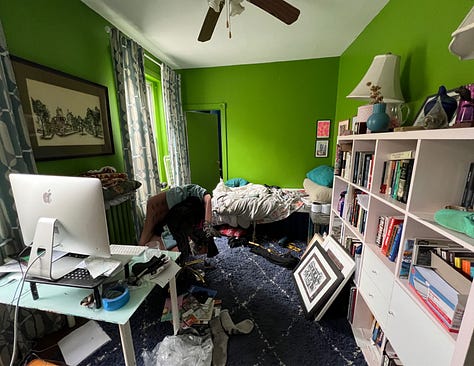
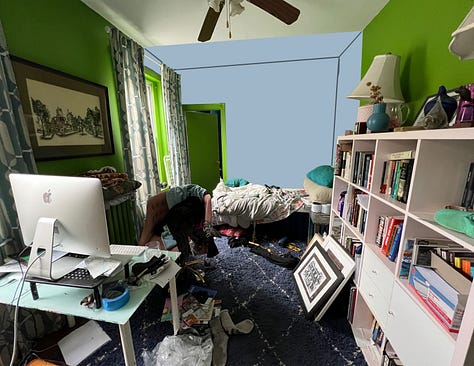
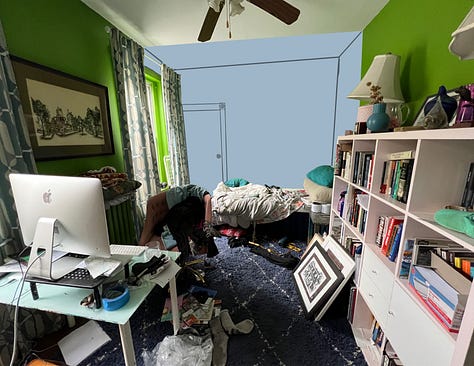
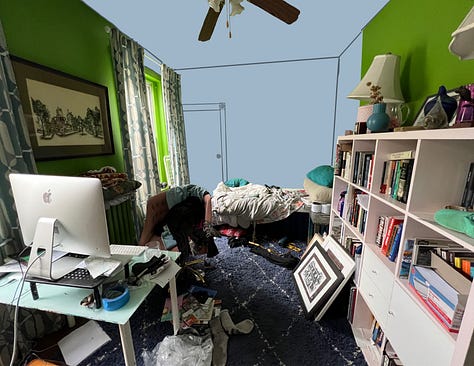
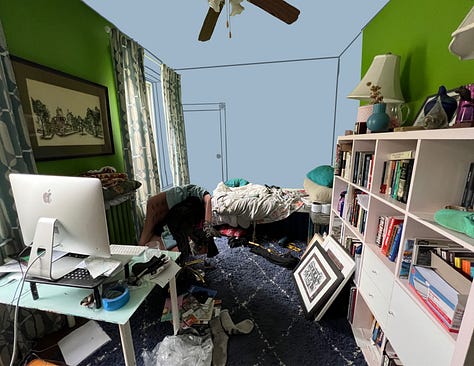
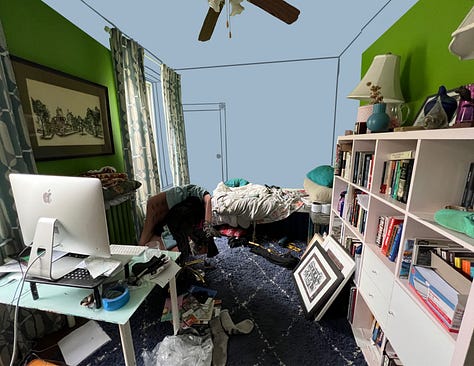
My goal in this project was to only use paint and supplies I already had on hand, and to finish as quickly as possible. I did manage to get by without spending any more money, but we have had a few setbacks (health and financial) in the past few weeks which have slowed me down. Such is life. One thing that you can ALWAYS count on with projects like this is that everything takes longer than you think it will….
Which is to say, this project is not quite done, but as I had hoped to get this post out last week, I decided instead to break it into two parts. Next week I will share some more thoughts about tracing my creative lineage, coming home to myself, as well as a full reveal of my new studio space!
In the meantime, I can’t tell you how much I would love to have you join me and my dear friend Meg Max to discuss and create home and spaces for making—and so much more!—in our brand-new course that will offer materials and invitations we’ve never offered before in an intimate setting with unparalleled access to the two of us and a small, supportive cohort of classmates. If I may toot my own horn a bit, I really do think what we are putting together is something so fresh and new and unique. I’ve never seen anything like it offered before. If you are at all interested in homemaking, interior design, neuroqueering space and time, unmasking, writing, creating, art-making and/or generally exploring the concept of 'home' for neurodivergent folks, you should definitely check out this course:
Coming Home To Ourselves: A Course for Neurodivergent Creatives
Overview
Coming Home To Ourselves includes:
Access to all slides and creative invitations shared in Coming Home To Ourselves, alongside AI-generated notes (sessions will not be recorded in order to maintain privacy in our sharing together)
Optional weekly Home Work to continue home making & creating outside of class
Ongoing community to share Home Work and continue the conversations begun in the course and create community connections (platform TBD)
Collaborative art-making opportunities through digital work or snail mail
Home Making Salon after the course is done
Aside from a pen and paper, no specific materials are required- participants are encouraged to approach creative invitations and home making applications with what they enjoy using and have on hand.
Please note that the structure and overview shared below may shift as we create this home together- we welcome the chance to adapt and grow to create a welcoming and comfortable community for the folks who share this space with us.
Class Structure:
Welcoming & reflection
Conversation (may include slides, examples of art, sharing spaces in Meg & Marta’s studios and homes)
Creation & application (reflective exercises, creation of art and home)
Sharing (A chance to share words & work)
Presentation of Home Work (optional ways to continue Home Making between in class sessions)
Closing thoughts & goodbyes
Course Overview:
Week One: Containers
In our first session, Meg and Marta will usher you over the threshold through an overview of our time together, community agreements and introductions. Using reflection and art making, we will explore where you currently live, what makes a welcoming space for you as an individual and us as a group, and how to make yourself and each other feel at home over the next six weeks together.
Week Two: Past
We all have a past, places we’ve moved through and carry with us. Ways we were taught to think and ways we were made to feel about our creative work and its worth. Through reflective writing and mapmaking exercises, we will explore our individual creative lineages as a way of answering the question: How did we get here?
Week Three: Homewrecking
Having mapped our paths to the present, we’ll explore the feeling of alienation that many neurodivergent people feel. Through design thinking, making and writing, we pull apart the places where we’ve landed and reconstruct home as a place that suits us rather than a place we contort to fit ourselves into.
Week Four: Present
A home can be four walls, a body, something outside of us and places internal. We explore practical ways of creating our homes in ways that suit our creative work, alongside reflective practices and invitations to make that will help us explore our present realities and prepare a home for our creativity.
Week Five: Wayfinding
Many of us feel outside, craving community but unsure of how to build it. Using creative making and reflective exercises, we will clarify our own needs, wants and desires, centering how to feel at home in shared spaces as a way of leading us to envision ecosystems of support and finding our way back to ourselves when we inevitably get lost.
Week Six: Future (welcoming ourselves home)
Welcome home.
[A note from Meg & Marta: We’re leaving this session a little ambiguous because one of the things we are the most excited about is being able to tailor this offering to the folks who show in the space. We imagine a chance to integrate what we’ve done in previous weeks, space for questions and conversation, and a celebration of all we’ve created and learned together.]
FAQs
How is this course different from Neuroqueering Your Creative Practice? (Or anything else you offer?)
Here are the biggest differences between NQYCP and Coming Home:
This course is a much smaller group- with a maximum of 15 participants registered per session.
Coming Home To Ourselves is a collaboration. Meg and Marta will both be present at each session. They've spiraled Marta’s beloved essays and presentations together with Meg’s practical, creative care invitations to make something brand new.
The content in this course, although touching on themes familiar to both Marta and Meg’s work, has not been offered before.
Although a weekly outline (provided below) will provide the framework, working in a small group allows the chance for Meg and Marta to tailor the course to the participants.
This course will offer more opportunities for direct interaction with Meg and Marta about participants’ individual projects, practices and processes.
More making, of both writing, art and home. (Imagine the chance to apply Marta’s Mis En Place for a project or space of your own, with them available to answer questions as you go.)
Optional Home Work, consisting of practical and creative ways to process your thoughts and experiences during our time together, will be provided, allowing you to continue to Coming Home between sessions.
How many people will be registered in each session?
There are a maximum of 15 participants registered in each session.
Who would benefit from this course?
People who are interested in exploring themes of home, unmasking and community through practical and creative applications.
Creatives of all kinds who have projects they’ve started, are stuck on, or want to begin.
Those who are looking for company to help them understand and feel less alone in their ways of being and making
Folks who have felt untethered from their bodies, creativity or communities
Artists aching for permission to live and create where and how they feel most at home
Why is the course so d*mn expensive?
As folks who believe deeply that accessibility includes financial accessibility, Marta and Meg really struggled with pricing this course. We knew we wanted to offer a true collaboration and new content, to keep the groups small, and both be present for each session. This means paying two people for their time, and when we did the math, there was no way we could make the course any less expensive while also paying ourselves anything close to a living wage. There are payment plan options for Coming Home To Ourselves available.
We also both offer free and low-cost community and classes - those spaces and options remain on offer through Divergent Design Studios and Writers in Bloom. If you can’t join us here, we hope to see you there.
If you have any questions about course content or structure, please contact me or Meg directly at: marta@martarose.com and meg@writersinbloom.com.
If you have any questions about ticket booking or payment plans, please contact KR Moorhead at krmoorhead.lit@gmail.com.





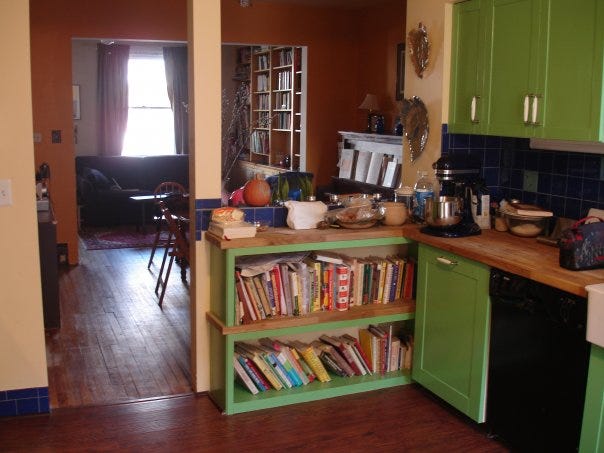
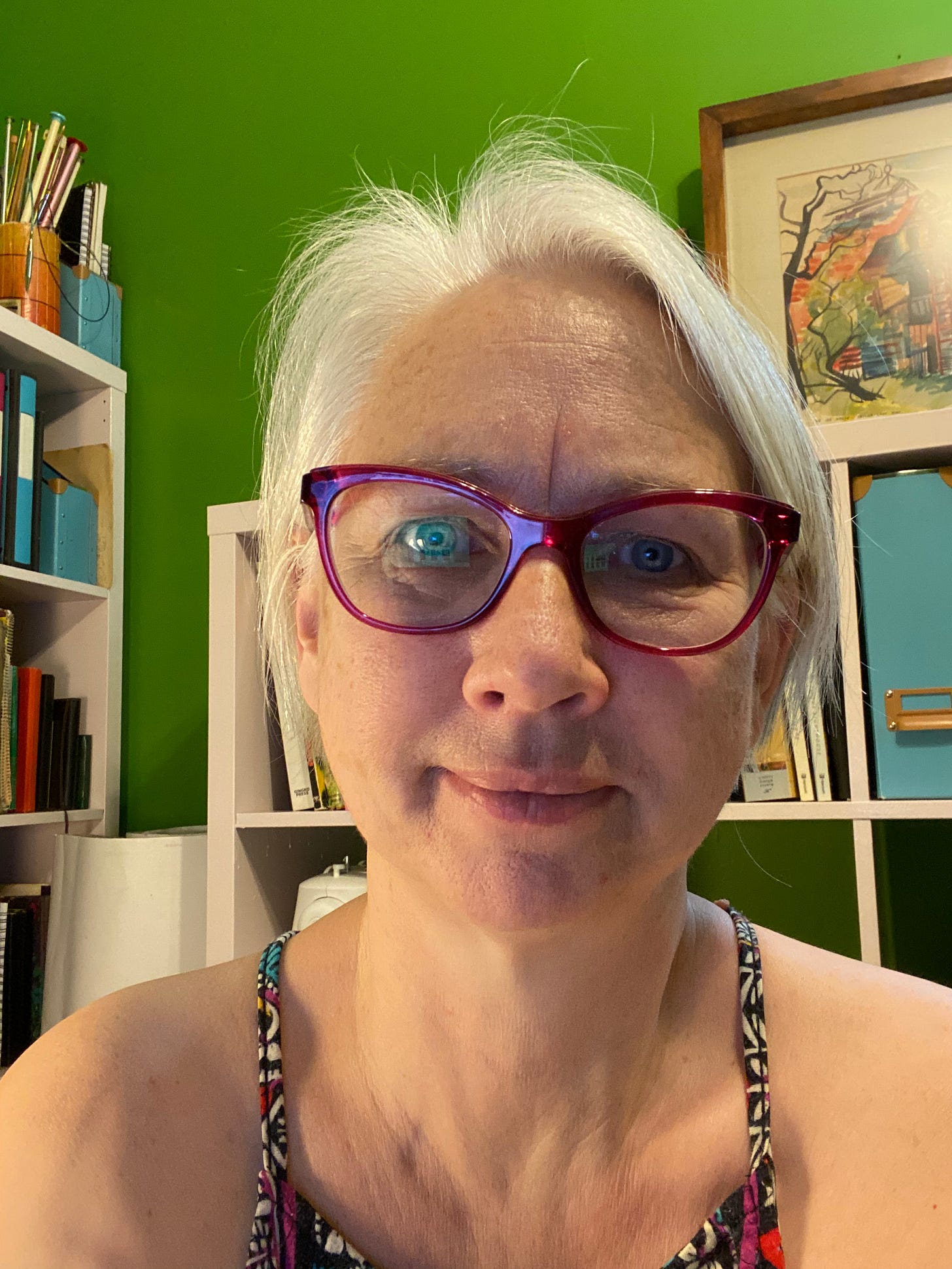
You have a fine writing style with unmistakable hints and traces of someone I used to know. The turns of phrase here and there evoke a voice across a kitchen table, the wok's aroma nearby. Hey chatzie!
A fine carpenter and cabinet-maker, indeed. O brother! : to cut out a set of cabinet elements from memory with all the allowances and in the right order was what he probably pursued. I suspect this work was a gift for you(r generation) rather than erudite studies of language structure and subtleties. Those, _you_ can carry on, uniquely transformed, as you wish.